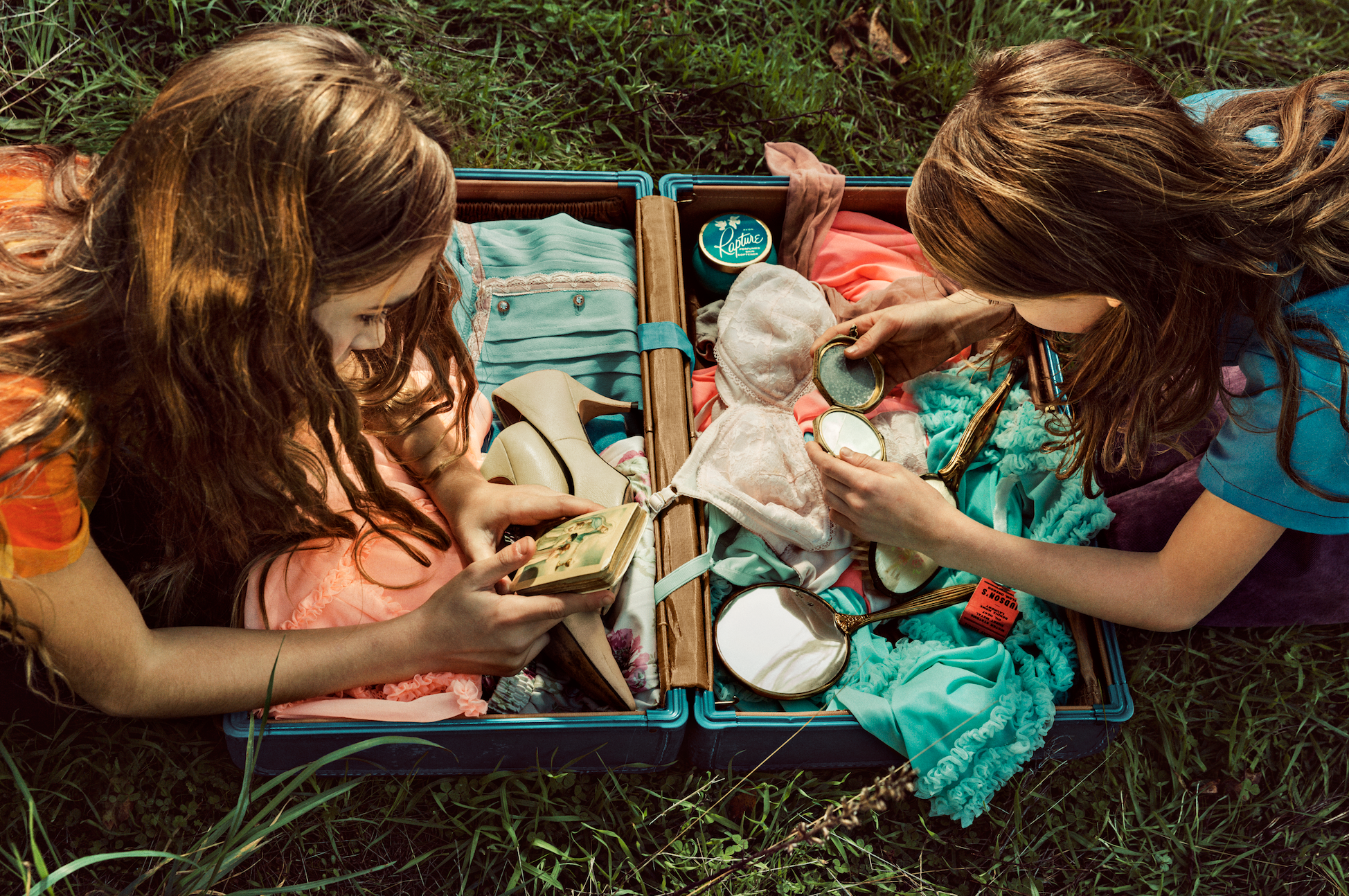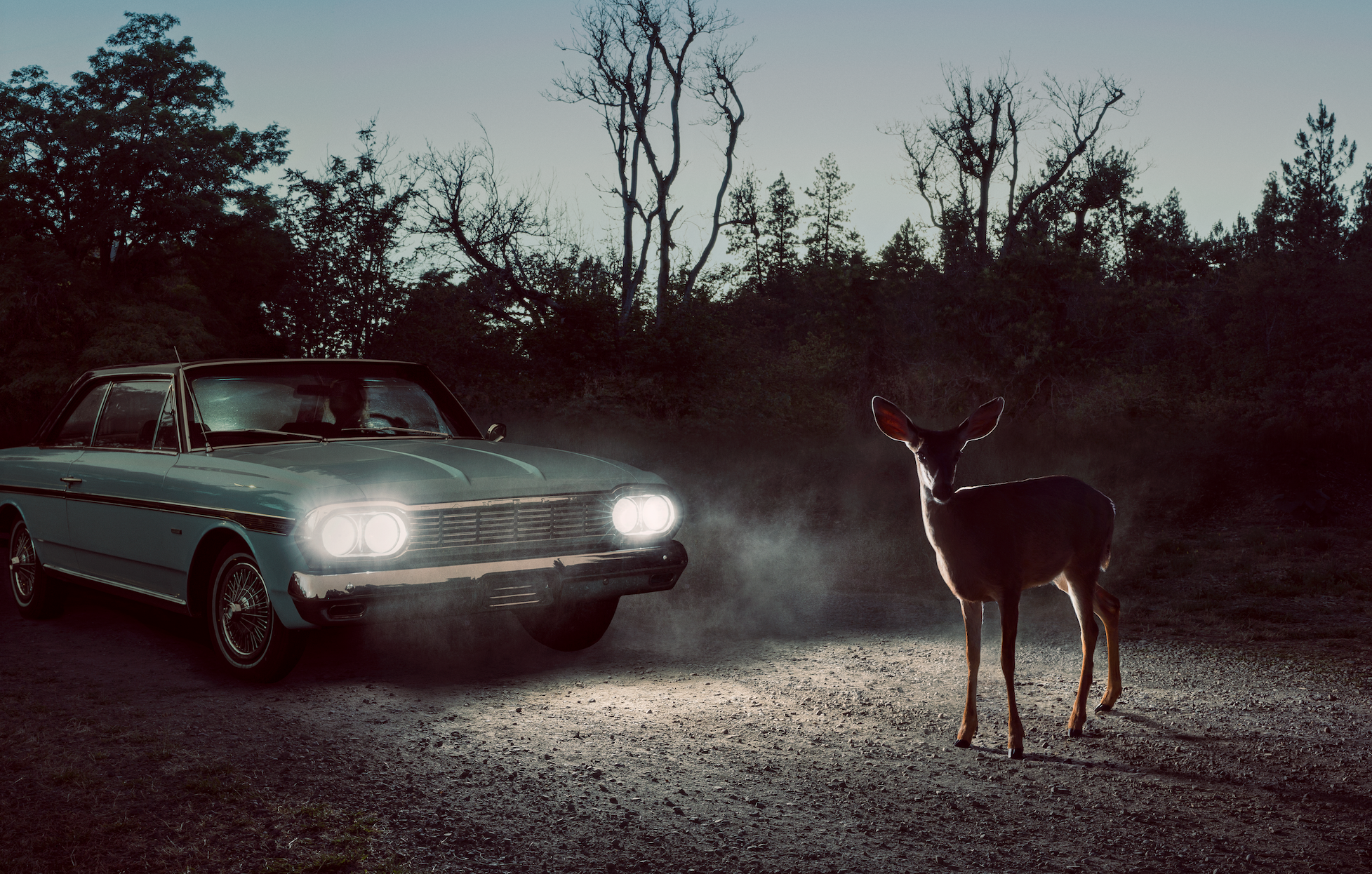Holly Andres


Portland photographer Holly Andres takes us back to explore the wonderment of childhood imagination through her beautifully crafted cinematic photography. In as little as a single frame an entire story unfolds. The viewer is invited to participate in the adventure of characters meshed deep inside a transformative journey from childhood to adulthood.
Andres has had solo exhibitions of her work shown from Portland to New York as well as internationally, and has been featured in The New York Times Magazine, Time, Art in America and many others. Don’t miss her latest series, The Fallen Fawn, showing at the Charles A. Hartman Fine Art Gallery in late March through May.
* * *
ELEVEN: What made you want to transition from painting to photography?
Holly Andres: My undergrad is in painting and drawing, and I still think that my foundation in painting really informs my photographic process. In particular, the compositions of my photos and the ways that formal elements like color, texture, pattern and light interact come from my knowledge in painting. When I am looking through the camera I often times look in the way that a painter might look at a canvas. When I studied undergrad at the University of Montana, it was a pretty traditional program with an emphasis on abstract expressionist painting, ceramics and pottery but I just remember being so compelled by large-scale color photography and video work. This was work that I wasn’t being exposed to as a student and I had this epiphany where I thought that if this was the work that I am most compelled by then perhaps this is the work that I should be making. After graduate school, I studied at the Northwest Film Center and I think it was there that I became really interested in the possibility of telling a story through a single frame. I think that while cinema is so powerful and so captivating and can stimulate so many more of your senses through editing, movement, layering sound and dialog, there is something so rich about a single image and having to contend with nothing but your own heart beating when you look at it.
11: You are from a very large family; how does that experience influence all of your work?
HA: I feel like my memory up until I was about 18 is like a steel trap and it’s a different type of memory, which is really vivid, rich and cinematic. I feel like as I get older I increasingly realize what a unique experience it was being the youngest of ten kids and growing up on a farm that was like a lawless land. My childhood memories offer me a fertile buffet that I always find myself returning to for ideas for my photographic work. Although I am not a mother or have much of a maternal instinct, I feel I am pretty enchanted by the childhood experience. I am also interested in those moments of losing that childhood innocence and that transition from child to adult, in particular of girl to woman.
11: Is there a name for the type of photographic aesthetic that you create?
HA: I have heard it referred to as staged or cinematic, narrative photography as opposed to conventional photojournalistic images. To borrow a distinction from a contemporary photographer, Jeff Wall whose work also falls into this realm, “We are farmers vs. hunters.” Most people might think about the process of conventional photography as just waiting for these beautiful, uncanny or surreal moments to present themselves and then capture them whereas photographers like Gregory Crewdson, Jeff Wall or Cindy Sherman and a whole host of other contemporary photographers, cultivate those moments, and much like a film director, craft them specifically to be photographed.

11: Are there any big lessons that you have gained from your photographic career?
HA: During my earlier photographic work on projects like Sparrow Lane, when I was still teaching as well, I was only shooting maybe a photograph a month. I had to transform, usually my own house, into a set using fabrics for wallpaper, shopping at thrift stores and estate sales for clothes and props and spending a lot of time crafting these installations that were then activated with my subjects. Because I was juggling the responsibilities of teaching, it could take me a whole month to find all of the things I needed for a shoot. For my latest series, The Fallen Fawn, my approach and process was more efficient because of the practice that I have gained from working for commercial shoots. For example, I found this really incredible house going to an estate sale and remember walking into it and feeling that it was already this immaculately art directed set, and it was staggering to walk into it. I later learned that the woman who died that lived there was a hundred years old, there was evidence that a bed had been moved downstairs and it seemed like there had not been anyone upstairs for decades. I was able to track down the woman who bought the house and rent it for five days. I hired a couple of assistants and a PA and spent the first two days cleaning and moving furniture in, since all of the original furniture had been moved out. I then spent two days shooting and I was able to shoot two separate series. In the matter of two days I was able to get about twelve images working with a bigger crew, so through my experience working on commercial shoots I have learned to be more efficient with setting up shots. That is the biggest thing that I have learned, that the more that you shoot the less clunky it feels and the more familiar and efficient you can become with your work.
11: Tell us a little about your latest series, The Fallen Fawn.
HA: A few years ago my oldest sisters where telling me that when they were young girls they found this suitcase on the river’s edge behind our house. They knew it was this really precious treasure that was filled with this woman’s life and they took it home and hid it under their bed. Sometimes late at night, or when they could, they would dress up in this woman’s clothes, put her curlers in their hair, and wear her makeup; there was even an ID in the suitcase. My sisters were these young, innocent girls that didn’t want their treasure to be taken away from them and it didn’t even occur to them that they were potentially walking into this kind of sinister story. I found myself thinking about that story and wondering about that woman, who she was, what happened to her, and why that suitcase was there. These are the types of narrative tropes that interest me, but I didn’t want to be too heavy handed about the woman’s story.
Like a lot of my photo series which are influenced by film, this series is told in a parallel fashion where there are actually two different stories that oscillate throughout. I wanted to kind of suggest some of the assumptions, like if there is a dead body for example, but I wanted the viewer to think a little bit or maybe arrive at their own thoughts about what happened. There is this sweet spot though, where I didn’t want the viewer to be so bewildered that they become frustrated and disengage and where I would like the viewer to arrive at their own ‘ah-ha’ moments without totally serving it up to them on a platter. I started with this image of a deer, this really fragile, beautiful deer in the headlights and thinking about the woman as this type of fallen fawn and a sort of fallen woman. I travelled five hours south to find a pot farmer that I was tipped off about because I was told he had this domesticated deer that I could use for the fawn. I thought about ways that her objects are kind of left behind and her story is left behind with them, like the car, the dog, and the contents of the suitcase. Somehow the suitcase makes its way outside and these girls find it and they start to kind of pilfer through it, through this woman’s life. Then I kind of inserted moments within each photo and the titles of each photo are very literal and almost like locations, like clues.

11: After your work is created, what do you get out of completing a project, how do you feel?
HA: When I come off of a creative project I actually usually go through a period of grief. The way that I work, I usually have a relatively specific image in mind or an essence of an image that I am hoping to recreate photographically and just because of all of these impossibilities there is always a distance between what was in my mind and what I was capable of creating and so there is always this period of profound grief. Once that grief dissipates a little bit though, certain qualities are revealed where I find that there may be something more to the images than I ever even imagined. »
– Lucia Ondruskova




